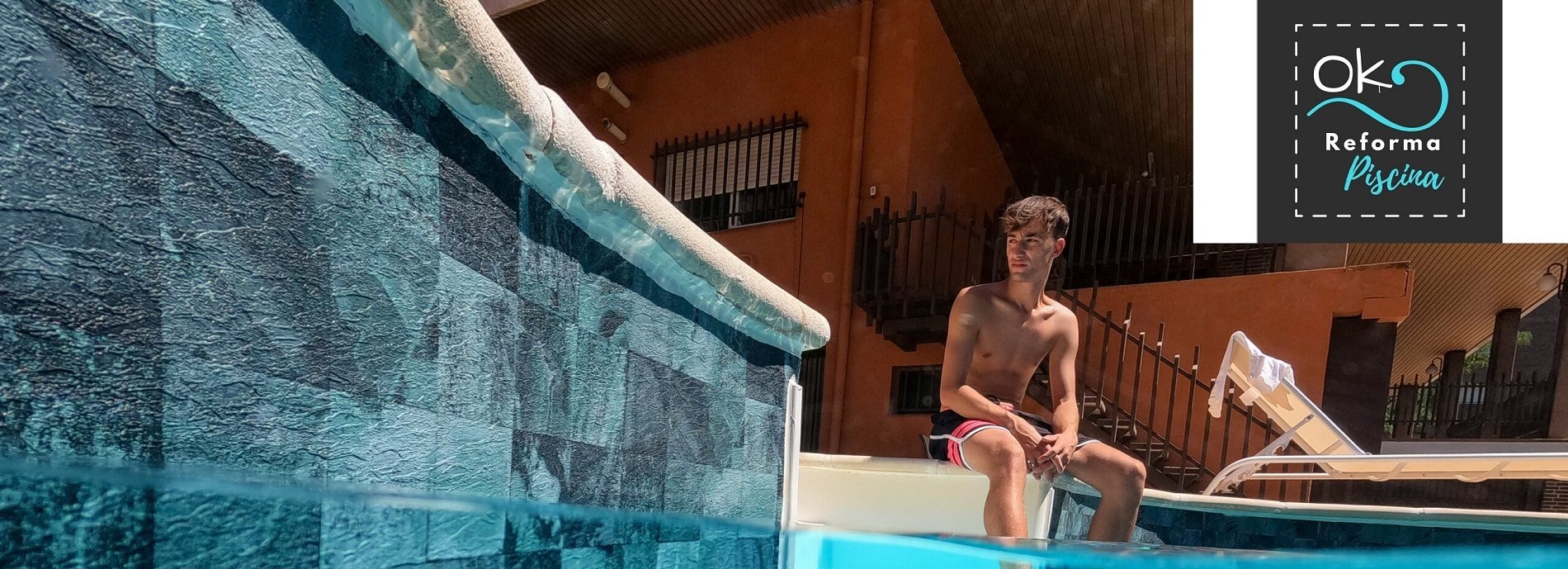
Table of contents of the page
En Ok Pool Reform we present the Main Causes of Water Leaks in Swimming Pools and How to Detect Them.
Main causes of water leaks in swimming pools and how to identify them
Diving into a refreshing pool on a hot summer day is one of the most gratifying pleasures, but what happens when that long-awaited water begins to mysteriously disappear? In this blog post we will show you the main causes of water leaks in swimming pools and how to identify them, so that you can fully enjoy your personal oasis without worries. Keep reading and discover how to keep your pool always ready for a dip!
Introduction to water leaks in swimming pools
Introduction to water leaks in swimming pools
Swimming pools are a great way to cool off and have fun during the summer, but they also require proper maintenance to ensure they function properly. One of the most common problems that can affect a pool is water leaks. In addition to being a nuisance, leaks can cause significant damage to the pool's structure and systems if not detected and repaired in time.
A water leak in a pool can occur for a variety of reasons, from external factors to errors during the construction process. In this section, we will talk about the main causes of pool leaks and how to identify them.
Common causes of pool leaks
A common cause of leaks in swimming pools is the natural wear and tear of the material they are made of. Cracks or breaks in the surface can allow water to leak out of the container. This may be due to continuous and intensive use, as well as sudden changes in temperature.
Another possible cause is the pressure of the surrounding terrain. If there are significant changes in ground pressure due to heavy rain or landslides, for example, this can exert force on the walls and cause cracks or separations between the materials.
Additionally, if construction was not done correctly or if there are problems with the hydraulic system, such as broken pipes or poorly sealed connections, leaks may also occur.
How to identify a leak
The first step to fixing a leak is to detect it. Some common signs that may indicate a pool leak are:
- Observe a lower than normal water level.
- Notice wet areas or stains on the surface around the pool.
- Hear the sound of running water even when the system is off.
- See cracks or separations in the walls or floor of the pool.
If you suspect a leak, you can perform some simple tests to confirm it. For example, you can place a bucket full of water on the steps or in the pool and mark its initial level. After 24 hours, check for significant changes in the water level both inside and outside the bucket. If so, there is likely a leak.
Water leaks in swimming pools can be caused by natural wear and tear,
My pool loses water: water leaks in structural pools
When is the time to repair pool cracks?
- The ideal time to repair cracks in the pool is in winter (you can contact us without any obligation).
- Basically, repairing the pool will involve emptying the pool. From another perspective, we also provide you with the page to learn how to empty the pool.
- So, we will also have to contact a technician and invest time.
- Apart from everything, If the pool renovation is carried out in summer, the high temperatures can make some of the renovation processes difficult.
Solution How to fix structural pool leak
Definitive structural pool leak solution: reinforced pool liner
Pool liner: guarantees the tightness of your pool. For all these reasons, we encourage you to consult our page about our reinforced sheet for swimming pools.
Reasons to repair water leaks in a pool with a pool liner
- Firstly, with our pool liner system, we can guarantee the tightness of your pool 100%.
- Furthermore, it is a modern system.
- There are multiple varieties and reinforced liner designs for swimming pools.
- On the other hand, the installation is very quick.
- It adapts perfectly to any type of pool regardless of its shape or the material it is made of.
- Healthy and safe system.
- In this way, you can avoid many risk factors for water leaks in swimming pools.
- And last but not least, we provide you with a 15-year warranty.
- What are you waiting for? Find out without any obligation!
My pool loses water: water leaks due to hydraulic system
In this case, we will treat the lost pool water due to a pool water leak due to the hydraulic system, that is, the PVC pipe network.
On the other hand, it doesn't hurt to consult our page dedicated to knowing how pool filtration works.
What is a water loss through a filtration circuit?
- A loss of water through a filtration circuit is a loss of water due to the filtration circuit (pool water filtering and recirculation system): Number and type of cleaning cycles.
- So, it is a water leak in the pool located between the filtration and pumping circuit, filling and emptying the pool.
- Are most common leaks (they represent around 80%).
- To repair them it is necessary to carry out pressure tests, section by section.
- It is a job that must be carried out by a specialized technician.
Generic problems due to pool water loss through pipes
Normally, Generic problems due to pool water loss through pipes usually occur for the following reasons:
- First most common case, pool water loss at the junction of the skimmer and the pipe.
- Or, lost pool water in the skimmer pipe where it settles with the ground
- Third, the pool loses water due to a crack in the skimmer itself.
- Or, perhaps, pool water lost at the connection of the skimmer pipe with the technical room
Detection of leaks in swimming pools through pipes
Next, we tell you the steps and procedures in a very simple and effective way to detect leaks in pools through pipes (which you can do yourself at home).
Step 1: Detection of leaks in pools through pipes: prepare the pool for the detection of the possible leak
- First step in detecting leaks in pools through pipes: we must have the water level of the pool in the middle of the skimmer (small pool window).
- Secondly, we will stop the pool pump and disconnect the differential.
- We will also close the skimmer, bottom and sweeper ball valves (put the handles perpendicular to the pipes).
- And then we will put the selector valve in the closed position.
STEP 2 Detection of leaks in swimming pools through pipes: water level control
- Find a way to write down and know the water level of the pool, either through, for example: a mark, by hooking a piece of tape or by counting tiles...
- In this way, throughout the necessary days depending on the case of water loss from the pool and always at the same time we will check the water level.
STEP 3 Detection of leaks in swimming pools through pipes: determination of the pool water level
Subtract until the water level remains stable over 24 hours, That is to say, let's not notice that this time the water has dropped, we will have to assess where the level has remained stagnant.
Pool loses water due to skimmer
If the water level is right at the mouth of the skimmer
- First possibility in pool leaks through pipes, the pool water level has stagnated right at the mouth of the skimmer.
- In this case, we will fill the skimmer with a hose and the result in principle will be that it never fills.
- In conclusion, We will have detected that the pool leak is due to the loss of water in the pool from the skimmer pipe being broken..
How to repair pool leak due to skimmer
To repair a pool leak due to a skimmer, we recommend that you contact us without any obligation., because a pool renovation must be carried out and in this case you must have knowledge and experience.
Generic procedure to repair pool leak due to skimmer
- First, make a hole behind the pool skimmer to uncover it.
- Depending on the slab and the mesh that the upper concrete belt has, it will better support the coping stone and the exposed belt.
- Fill the skimmer and start the filtration if you do not see the water leak, sometimes the leak occurs when the pipe increases the pressure due to the suction or delivery.
- If you detect the leak, you must check if the skimmer can be saved or you must replace it and make a new connection.
- For accessories that need to be joined with glue, leave the area clean before gluing.
- Leave the times indicated by the PVC glue you are using.
- Check that it no longer leaks and leave it for about 24 hours to confirm that it is no longer leaking in that area.
- Once confirmed then cover the area.
Video tutorial how to repair leak in pool by skimmer
Below is a video tutorial that will teach you how to repair a leak in a pool due to a skimmer by repairing the pool pipes.
Although, as we have said before, in this case if you have this problem of water leaks in pool skimmer, we recommend that you contact us without any obligation.
Pool loses water due to aspiration
If the water level is right at the suction nozzle of the sweeper:
- On the other hand, if the water level remains in the suction nozzle of the sweeper: plug the nozzle and fill above to check.
- In this case, We will have detected that the pool leak is caused by the loss of water in the pool coming from de the sweeper pipe which will be broken.
Pool leaks water from impellers
If the water level does not match any nozzle
However, if the water level does not match any nozzle, we must proceed to:
- Open only the bottom ball valve and set the selector valve to the filtration position.
- Start the engine.
- If you see the water level go down, the problem The pool leak occurs due to the loss of water in the pool coming from of the delivery pipe.
Pool loses water due to pool light
If the water level is right at the height of the lights
- If the water level is right at the height of the lights, the reading is easy, we have a problem in some joint of the lights.
How to fix pool leak in focus
- Firstly, empty the pool below the spotlights.
- Secondly, check each of the light bulb joints (usually it is a matter of the stuffing box joint that includes the light niches). As you should already know, the spotlight niche is the housing where the spotlight is housed.
- Specifically, you will find 4 gland gaskets (two in the housing where the niche sits and 2 in the niche itself).
- Check and inspect each gasket completely and replace it if there is the slightest suspicion.
- Next, we place the niche inside the casing and fill the pool at the level of the skimmers.
- Then, we will have to wait a few days to authenticate the result.
Video tutorial How to locate a water leak in a pool source
In this video tutorial, you will see how to locate a water leak in a pool source in a professional and specialized way.
In addition, pool leak detection is carried out by testing pool tightness without emptying the water.
And with all this, we present you a solution on how to locate a water leak in a pool source with and without emptying, As always, you can contact us without obligation.
How to know if there are water leaks in swimming pools
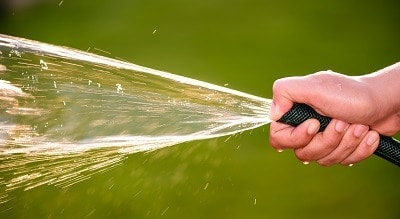
Homemade indicators to know if my pool is losing water due to a leak
1st warning that there may be a pool water leak
- If the water bill has increased.
2nd indicator to check if there is a pool water leak
- Sign in the pool: Mark the water level with a piece of tape or similar and check 24 hours later if the water level has dropped more than 0,5cm (if it has dropped 0,5cm or more, there may be a leak).
3rd home method to know if there is a pool water leak: bucket test

Procedures to know if there is a pool water leak with the bucket test
Cube test: Place a small bucket of water on the pool stairs, matching it to the water level and placing a weight on it to make it stable.
- Fill a 20 liter water bucket with water from the pool.
- Place the bucket on the first or second step of the pool (preferably on the second, without immersion).
- You must then turn off the bomb and then make a mark on the inside of the bucket to mark the internal water level and one on the outside of the bucket to mark the water level of the pool.
- Subsequently, we resume normal operation of the pump (all this ensuring that the automatic filling of the pool is turned off during the test9.
- After 24 hours, check that the water level inside the bucket and outside has decreased proportionally, otherwise it will be synonymous with a leak.
How to detect a pool leak
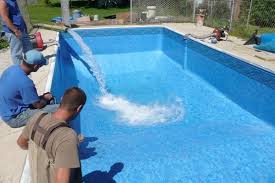
One of the important points when we have doubts about whether our pool is leaking water or not is to check whether or not there really is a water leak.
Types of tests to find a leak in a pool
- Leakage tests with infrared camera.
- Detection with pressure gas.
- Leakage tests with ultrasonic detector.
- Pressure tests with a pump.
- Checking tightness in pipes.
- Conducting tests with a diver through an endoscopic camera.
How to detect water loss in a pool without products
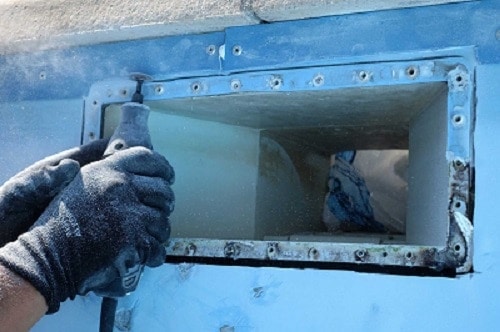
Pool leak detection turning off the filtration system
Possible readings of water loss in the pool by turning off the filtration
- If the water goes down and stops in the skimmer, it means that the leak is either there or in the filtration system.
- On the other hand, we can check if the water descends and stops at the bulb, the leak is surely in the projector.
- Another way would be if the water descends and stops below the bulb, the leak is surely at the bottom of the pool or in the lining of the pool.
- If the pool continues to leak when the pump is running, the leak will be in the recovery system.
Video tutorial how to detect water loss in a pool
Next, the video that we provide you is in case you have previously noticed Lost pool water.
As we said, in this video you will be able to see the steps to detect pool leaks.
In addition, no liquid or tool is used to more quickly detect water leaks in swimming pools.
In any case, as additional information, it is true that there are pool products on the market for this purpose.
How to detect a pool leak with ink
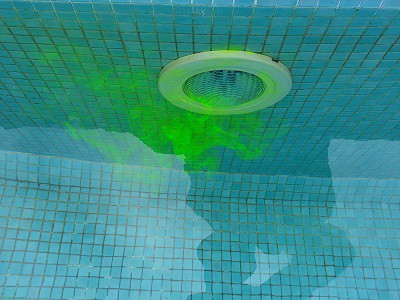
What is the dye test for pool leak detection?
The dye test for leak detection in swimming pools is a product that can be purchased and gives us a guide to know where the leak is, since if there is a hole in the glass or walls of the pool, the dye will mark it.
Thus, it is still a syringe loaded with ink that is not soluble in water that allows possible pool water leaks to be detected using the ink in areas suspected of structural leaks.
In this way, we can rule out or confirm water leaks in the glass or ABS inserts.
Pool leak detection analysis ink
Pool leak detection analysis ink characteristics
[amazon box= «B004IM4LDS » button_text=»Buy» ]
Video tutorial How to detect a pool leak with ink
In this video we show you how to use the special ink for pool leaks, which helped us find a small leak that we had in the tubes of our pool purifier.
How to detect a pool leak

Advanced technology Ok Pool Reform to locate leak in pool
1st method Pool leak detector: Thermal camera
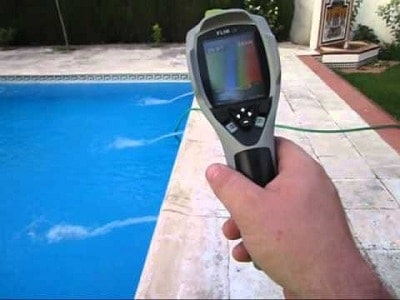
- It is a Reliable and accurate tool for locating water leaks in pool pipes, walls and concrete floor.A totally new system capable of locating filtration points, saving time and money.
- It has become the essential tool capable of generating graphic documentation of water leaks in swimming pools quickly and accurately.
2nd method Pool leak detector: Geophone
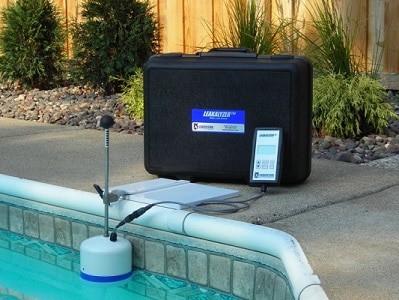
- Electroacoustic water leak detection equipment.
- The geophone pool leak detector is placed on the surface to be investigated and precisely locates the sound waves produced by the damaged pipe.
- Provide certifications once the leak is repaired. Take the measurement and print it on a computer.
- Confirm that a leak exists before beginning testing.
- Confirm that leaks have been fixed upon completion of the repair, saving time and money.
3rd method Pool leak detector: Pipe inspection cameras

- Pipe inspection cameras allow us to enter the pipe to assess the pool leak.
4th method Pool leak detector: detect leaks in pool glasses

- Pool leak detector: leak detector in pool vessels such as fissures, cracks, special fluorescent dyes.
- This method of locating the pool leak is based on a special dye for this function.
- Pool leak dye is very thick and remains suspended in the water.
- And, in the event that there is a leak in a delivery nozzle, in a focus, crack, or in another place, the dye is absorbed immediately to be able to see in a very visual way that there is a pool leak.
How to locate a leak in a removable pool

How to locate and repair a leak in a removable pool
Why do water leaks occur in removable pools?
- The canvas or liner is one of the main pieces of a removable pool.
- This is the part that contains the water, so its care and maintenance so that it is always in good condition will guarantee the proper functioning of the pool and the purifier, in the cases of medium and large-sized pools.
- In any case, in order not to damage the removable pool during its regular cleaning, we suggest you consult the entry about pool cleaning in its specific section on removable pools.
Better to line with pool liner for better leak resistance removable pool
- The material with which the tarp is made is usually PVC plastic, a flexible and highly resistant material at the same time, since during use it is exposed to friction, pressure and tension.
- The thickness of the tarp also determines its resistance with a simple rule, The greater the thickness, the greater the resistance.
How to find a leak in an inflatable pool
Methods to locate a leak in a removable pool
- Dive into the pool and look for the leak by feeling the canvas or with diving goggles
- Look outside the pool for puddles.
- Check the tubes that connect to the purifier
- Let the pool empty itself and see if at any point it stops emptying.
- If your pool has an access ladder, make sure the legs have not damaged the base.
Locate a leak in a removable pool with the bucket test
Procedures to know if there is a pool water leak with the bucket test
- Cube test: Place a small bucket of water on the pool stairs, matching it to the water level and placing a weight on it to make it stable.
- Next, make a mark on the inside of the bucket to mark the internal water level and one on the outside of the bucket to mark the water level of the pool.
- After 24 hours, check that the water level inside the bucket and outside has decreased proportionally, otherwise it will be synonymous with a leak.
How to locate leak holes in removable pool
Most common causes of water leaks in swimming pools
Pool leaks can be a common and frustrating problem for homeowners. Not only can it cause water losses, but also additional costs in repairs and maintenance. It is important to know the most common causes of these leaks in order to identify and solve them in time.
The first common cause of water leaks in swimming pools is ground pressure. This occurs when the soil surrounding the pool expands and contracts due to climate changes, putting pressure on the walls of the pool. Over time, this pressure can cause cracks or breaks in the structure, allowing water to seep out.
Another common cause is damage to the pool liner. If the liner is worn or has been installed incorrectly, it can allow water to escape through small cracks or holes invisible to the human eye. Additionally, if the pH and chlorine of the water is not properly maintained, this can corrode the coating and cause leaks.
It is also important to note that any type of pointed or sharp object inside the pool (such as branches, stones, or other objects) can easily puncture the liner and create major leaks.
Another possible reason is a leak in underground pipes. Sometimes these pipes can break due to sudden changes in temperature or the growth of nearby roots. If there is an underground leak, you may notice wet areas around the pool or an increase in your water bill.
Last but not least, a common cause of pool leaks is worn or damaged fixtures. Lights, skimmers and jets can deteriorate over time and allow water to escape. Therefore, it is important to regularly inspect these items and replace them if necessary.
If you suspect your pool has a water leak, it is important to take action quickly to prevent further damage. Be sure to review all of these possible causes and seek professional help if you can't locate the leak on your own. With early detection and proper repairs, you can prevent major problems and enjoy your pool worry-free all summer long.
How to identify a water leak in your pool
Pool leaks can be a common and costly problem for homeowners. In addition to affecting water quality, it can also have a negative impact on the structure and operation of the pool. Therefore, it is important to know how to identify a water leak in your pool so you can fix it in time.
The first sign of a possible leak is when the water level constantly drops for no apparent reason. If after filling the pool with water, you notice that the level drops faster than normal, it is very likely that there is a leak. You may also notice puddles around or under the pool, especially if it hasn't rained recently.
Another way to identify a leak is by looking at the walls and floor of the pool. If there are dark spots or white marks in these places, it may indicate leaks behind the coating or in underground pipes. Likewise, if you find cracks or breaks in the siding, it is important to check for any water leaks.
Also pay attention to any unexpected changes in the chemical consumption of the water. If you have to add more chemicals to maintain proper pH balance and other levels, it may be because there is a leak that is diluting the chemicals.
A simple but effective method to detect leaks is by using a floating bucket. Fill a bucket with water to the same level as your pool and place it on one of the steps or submerged shelves within the pool area. Mark the water level inside the bucket and wait 24 to 48 hours. If when you check again, the water level in the pool has dropped lower than in the bucket, it is a sign of a leak.
If you suspect there is a leak in your pool, it is important to act quickly to prevent further damage. First, close all water supply valves to the pool to temporarily stop the water loss. Then, contact a specialized professional to perform a proper inspection and repair.
Identifying a water leak in your pool requires paying attention to unexpected changes in the water level, stains or marks on the walls and floor, abnormal chemical consumption, and using simple methods such as the floating bucket. Act quickly in case of any
Steps to repair a water leak in the pool
Steps to repair a water leak in the pool
Once you have identified the cause of the water leak in your pool, it is important to act quickly to avoid further damage and costs. Here we present the steps you must follow to repair a water leak in your pool.
- Empty the pool: The first thing you should do is completely empty the pool until only a little water remains at the bottom. This will make it easier to see exactly where the leak is.
- Locate the leak: Using a cloth or absorbent paper, carefully dry all areas around the edge and walls of your pool, paying special attention to joints and cracks. If you find a wet area or notice any drop in water level, then that's probably where the leak is.
- Mark the location: Once the leak is located, mark its location with chalk or some easily visible object so as not to lose sight of it during the repair process.
- Prepare the area: Carefully clean the area where the leak is located, removing any debris or dirt that could interfere with the sealing process.
- Apply epoxy putty: Using an epoxy putty specifically designed for repairing pool leaks, apply a generous coat to the affected area. Make sure you completely cover all cracks and crevices.
- Smooth and let dry: Using a spatula or smooth knife, smooth the putty so it is even and make sure there are no bubbles. Allow to dry completely according to product instructions.
- Fill the pool: Once the putty dries, you can fill your pool again with water to its normal level.
- Verify the repair: Wait 24 hours before using your pool again and check to see if the water level has decreased. If the problem persists, it is possible that there is more than one leak or that it is larger than you thought, so you will have to repeat the previous steps more carefully.
- Take preventive measures: To avoid future leaks in your pool, it is important to take preventive measures such as performing regular maintenance, periodically checking joints and cracks, and repairing any damage immediately.
Repairing a water leak in your pool can
Tips to prevent future water leaks in your pool
Tips to prevent future water leaks in your pool
Water leaks in swimming pools can be an annoying and expensive problem. Furthermore, if not resolved in time, they can cause serious damage to the structure of the pool and its surroundings. Therefore, it is important to take preventive measures to avoid future water leaks in your pool. Here are some useful tips to help you keep your pool in perfect condition:
- Perform regular inspections: The best way to prevent a leak is to detect it early. Therefore, it is advisable to perform regular inspections on your pool to identify any potential problems before they worsen.
- Maintain the proper water level: Too high or low a level can put pressure on the walls and bottom of the pool, which can cause cracks and leaks.
- Check the filtration and cleaning system: Blockages or problems with the filtration or cleaning systems can cause accumulations of water that can exceed the capacity of the system and cause a leak.
- Take care of chemicals: Excessive or incorrect use of chemicals can corrode pipes and damage the overall structure of the pool, which can lead to leaks.
- Keep an eye on fixtures: Lights, pumps, valves and other fixtures can also be potential sources of leaks if they are not installed correctly or are worn.
- Avoid sharp objects: Do not allow sharp objects into the pool, as they can damage the liner and cause leaks.
- Control the water pressure: The water pressure in a pool can be a determining factor in the appearance of leaks. If you notice that there is excessive pressure, it is important to check the pipes and accessories to avoid possible leaks.
By following these tips and maintaining your pool well, you can prevent future water leaks and ensure you enjoy it without having to worry about costly repairs. If you suspect that there is a leak in your pool, do not hesitate to contact a professional to fix it as soon as possible. Always remember to take good care of your pool to prolong its useful life and avoid major problems in the future.
Conclusion and final recommendations
Conclusion and final recommendations:
Water leaks in swimming pools are a common but very important problem that must be addressed in a timely manner to avoid further damage. By quickly identifying and repairing the causes of these leaks, you not only save on maintenance costs but also ensure a safe, properly functioning pool.
To conclude, it is essential to perform regular maintenance on your pool and keep an eye out for any signs of water leaks. If you notice any drops in the water level or wet spots around the pool area, it is important to take immediate action to avoid major problems.
Furthermore, it is always advisable to hire the services of professionals specialized in pool repair and maintenance to ensure an adequate and long-lasting solution. These experts have the knowledge, experience and tools necessary to identify and fix any type of leak in your pool.
Finally, remember that prevention is key to avoiding future leaks. Regularly inspect your plumbing system and make sure you maintain a proper balance between water chemical levels. Also, avoid overloading your pool with excess people or heavy objects that could damage the liner or pipes.
In conclusion, if you suspect that your pool has a water leak, don't wait for it to get worse. Act quickly and implement these recommendations to identify the exact cause and repair it appropriately. This way you can enjoy a safe pool in optimal conditions all year round. Keep your pool in good condition and enjoy a worry-free summer!
